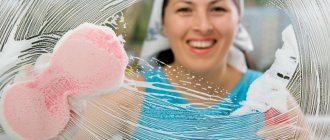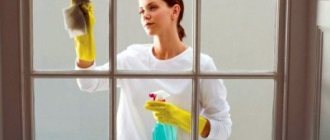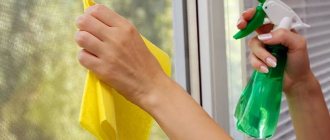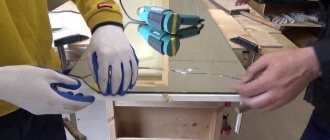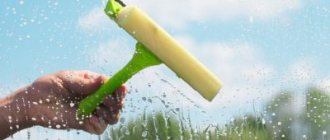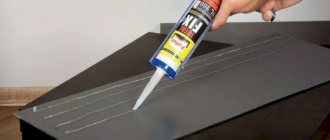Usually there are several mirrors in an apartment: in the bathroom, bedroom, hallway. Each one needs to be looked after regularly, as fingerprints and other dirt not only spoil the overall appearance of the room, but also reduce light reflectivity.
However, it is quite difficult to wash them so that they shine. After cleaning, stains often appear on the mirror, which spoil the appearance almost more than the dirt itself. You can avoid such unpleasant consequences. There are many ways you can wash a mirror, but first you need to figure out why they form.
Special products for cleaning mirrors
There are a lot of products for cleaning mirrors, which include aerosols, foams, and wipes soaked in a cleaning composition. Let's take a closer look at the most popular of them.
Mister Muscle
A common popular glass cleaner, available in the form of a multi-colored liquid in spray bottles. It contains ammonia, propane and isobutane. Breaks down dirt and polishes the surface. It has a rather pungent odor of ammonia. Very popular among housewives because of the quality, and because of the replaceable inexpensive blocks that save the budget.
Spectrum-PROFI
Available as an aerosol. Professional detergent for glass and ceramic products. Can be used at low temperatures. It copes quite well with all types of household pollution.
Aquapel
A device designed to protect car windshields is popularly called “anti-rain.” It is loved not only by drivers, but also by housewives. Thanks to a carefully selected formula, it prevents the appearance of stains and streaks on the glass and makes it easier to remove insect residues. Available as a set in the form of a gel, which is applied to the surface with a special sponge and rubbed in until completely dry.
Help
Product made in Russia. Sold in clear plastic spray bottles. Consists of water, isopryl alcohol, surfactants and excipients. The chemical composition is safe to use.
Amway
An effective product for ideal, streak-free cleaning of glass and mirrors. Available in concentrated form. Before use, you need to dilute - three parts water to one part substance. The manufacturer claims that it contains only ingredients from natural sources that have passed dermatological testing.
Clin
This is an Austrian household chemical product. The dispenser is especially well made: it can be applied in the form of tiny drops or in the form of foam. Thanks to this, it is not only effective, but also saves family money.
Frosch Glass Cleaner
The composition includes special ampholytic surfactants, which are of plant origin and are completely biodegradable. Despite its naturalness, the liquid perfectly dissolves fat and protein and is easily wiped dry.
7 recommendations on how to properly place mirrors in your apartment
Cif
A series of Hungarian cleaning products for cleaning residential premises. Safe and effective. Produced in plastic bottles of 500 ml, economical, without a strong odor.
Ecover
Belgian glass cleaning liquid. Has a natural light aroma. Absolutely hypoallergenic, can be used without fear in bedrooms and children's rooms.
Synegetic
One of the effective products of this Russian brand is a product for cleaning windows, mirrors and adding shine. The entire line has passed numerous clinical trials in various research institutes and complies with SanPin standards. Therefore, its use is safe, effective, and economical.
Automotive facilities
Car chemicals, in addition to cleaning the mirror well, protect it with an invisible film and simplify further maintenance. However, it is worth paying attention so that the chemistry is not aggressive to frames and furniture and does not damage them. The room where auto chemicals are used must be ventilated and fireproof.
Monitor cleaning liquid
If necessary, you can use special liquids for cleaning computer monitors. The only negative is that they contain few polishing substances, but they clean stains and dust well. The composition also contains antistatic agents that reduce the attraction of dust particles.
Napkins
Cleaning wipes - wet, soaked in a special composition, or dry, will also help clean the surface of dirty stains, polish it and provide an antistatic effect. It is convenient to store the napkins next to the mirror, and if it gets dirty, wipe it immediately without using liquid products.
Common mistakes when washing
Contamination not only spoils the appearance of the product, but also impairs its reflective properties. And unattractive stains can appear even immediately after washing. This is due to common mistakes that housewives can make during the cleaning process:
- Insufficiently clean water was used.
- Before washing, the mirror was not cleaned of dust and degreased.
- Washing was carried out with too wet or dirty rags.
- Poor quality rags or sponges were selected.
- The algorithm of actions during operation is broken.
To ensure that all the mirrors in your home shine and shine with cleanliness, you should follow simple rules when caring for them.
Folk remedies for cleaning mirrors
In addition to modern chemicals, you can use folk remedies to clean the mirror.
Ammonia
Ammonia, or ammonia, is included in almost all cleaning products. There are two compositions you can make at home:
- Take ammonia and tooth powder in equal proportions, mix well until smooth, apply and let dry slightly. The resulting paste is removed with a dry soft cloth.
- Mix a tablespoon of ammonia in a liter of water and wash the mirror. Wipe dry.
Salt
Dissolved salt removes old dirt and traces of insect activity. To do this, take table salt and warm water in proportions of 1 to 10, stir well, wash the surface and wipe dry.
Wet fine table salt will clean dried gum and sticker stains well.
Potato
The starch contained in potatoes will add shine and remove dried stains. Used in two ways:
- Raw peeled potatoes are grated on a fine grater or crushed in a blender to puree, filter through a sieve. The juice is allowed to settle. Rub any glass with wet starch, then rinse it off several times and wipe it with a rag.
- For minor contamination, cut the peeled potato into two halves and wipe the cut surface on a mirror. Then wipe with a dry cloth.
Milk
You can bring shine by soaking a swab in milk of any fat content and wiping the entire area several times. Then polish.
Blue
Blue, diluted in water or milk, adds shine, freshness and gloss. To do this, blue powder is dissolved in water, washed and wiped.
“Mom, I crumbled a little here”: how to clean the keyboard from small dirt
And if you add a few drops of ammonia to the blue solution and pour the mixture into a spray bottle, you will get a ready-made product for cleaning any glass surfaces.
Alcohol
Alcohol in a solution with water will not only add shine, but also remove old stains. Particularly contaminated surfaces are wiped with pure alcohol or vodka.
Onion
Use half a fresh onion to wipe the mirror to clean dirt and repel flying insects. Onion gruel is used to remove particularly old stains that require pre-soaking.
Chalk
Chalk slurry is prepared from equal proportions of loose chalk and water, applied to a surface, allowed to dry a little and removed with paper napkins. Then polish with a soft cloth.
Toothpaste and powder
Tooth powder is diluted with water, and toothpaste is taken in its standard form. Apply, rub in thoroughly and remove with a paper napkin. Perfectly polishes small chips and scratches.
Vinegar
It is good to wash mirrors with vinegar diluted in water at the final stage to add shine and remove stains. Vinegar is diluted in a ratio of 1:10, and vinegar essence is diluted in a ratio of 1:100.
Wax
Wax is, first of all, a polish. It perfectly matts small scratches and protects the frame from moisture.
Turpentine
To remove particularly stubborn stains - traces of oil paint, cosmetics - turpentine is used. Remove stains with a dampened swab, then wash with detergents and polish.
Paper
Using ordinary sheets of newspaper, you can add shine to washed glass and remove stains. This is facilitated by both the chemical composition of printing ink and the structure of newsprint. To do this, sheets of paper are crumpled into a loose ball and wiped over the surface. The lumps are changed several times.
Capron
You shouldn’t throw away worn-out ordinary nylon tights - they can turn into a good way to wash glass. To do this, they are folded several times so that a shape is convenient for the hand, and any object on which it is necessary to avoid the appearance of stains is washed, like a sponge. You can use any product and then polish. Thanks to the specially woven nylon, there are no streaks left, and moisture is completely absorbed by such a homemade sponge.
Which napkins are best to use?
To achieve a good result, it is important which rag is best to wash the mirrors with. Soft rags made of lint-free fabric are more suitable, since they will leave no threads or fibers behind. Microfiber cloths are ideal for such purposes.
A microfiber cloth will help you wipe the mirror surface perfectly.
It is undesirable to use rough sponges, as they can damage the surface. As a rule, housewives use soft sponges and special napkins.
Cleaning mirrors without streaks
In order to avoid streaks, firstly, the rag must be chosen correctly. Secondly, the mirror surface should be wiped in one direction - from right to left, or from top to bottom. This point must be especially taken into account during final polishing.
Children painted the walls with wax crayons: a life hack on how to clean wallpaper with a hairdryer
How to wash properly?
Regardless of which method of washing the mirror surface was chosen, the procedure is carried out according to the same algorithm. Glass is cleaned using household chemicals and liquid made independently. After this, the applied product is washed off the glass. It is better to use cold water and a special brush with a rubber element to drive the liquid down, which quickly dries the glass without streaks. Only after this is the mirror surface polished by rubbing with newspaper, toilet paper or microfiber.
Features of removing various contaminants
The easiest way to remove dust from a mirror surface is. But there are stains that cannot be erased without much effort.
- Limescale. Limescale deposits are removed with an acidic medium, for example, vinegar. In addition, a very large stain can be removed with a plumbing gel to remove limescale.
- Sticker marks. Traces from stickers are soaked with hot water and scraped off with a scraper. It is also good to remove such stains with nail polish remover.
- Marker. “Artistic creativity” with a marker on the glass is removed with a swab moistened with alcohol or vodka. Then they rub it.
- Traces of insects. Traces of insect activity can be removed with a weak solution of baking soda. Old stains are soaked by repeatedly wiping with a cloth soaked in a solution, and then polished.
- Cosmetics stains. Stains from cosmetics or cosmetic preparations are usually fat (lipstick, mascara, cream). To dissolve the fatty base, use an aqueous solution of any dishwashing detergent.
- Oily spots. In general, any greasy stains can be removed using a cleaning solution. If they are old and dried out, they should first be soaked and then removed with a hard (but not metal) sponge or scraper. You can also wipe off the grease with paper and then wash it as usual.
Little tricks
These tips are simple but effective:
- A bathroom mirror will not fog up if it is treated with one of the following substances: shaving foam, fabric softener or gelatin solution (1 teaspoon of powder per 1/4 cup of water). The selected product is applied to a rag made of natural material, and then rubbed onto the mirror surface. Another way is to add a little glycerin, literally one drop, to the mirror cleaning solution.
- The following recipe will help protect the mirror from dampness and the appearance of dark spots on the back side: take 1 part melted wax and 2 parts turpentine, mix. Apply the mixture to the back of the product. Attention: you need to act quickly before the wax hardens.
- The mirror will always delight you with cleanliness and shine if you regularly wipe it with a fiber cloth. In addition, once every 2 weeks, treat the surface with a cloth soaked in vinegar, finishing the procedure with polishing.
Step-by-step instruction
To summarize how to properly wash a mirror without streaks, you can create the following step-by-step algorithm. And the use of various means, both improvised and special, comes down to one chain of actions that must be performed sequentially:
- The first step is to clean the contaminants with any of the products that have been listed. The more aggressive the composition, the faster the cleansing will occur. Sometimes it pays to get your priorities right. What's more important: speed or safety? Natural and improvised means are cleaner from an environmental point of view.
- The second step is to wash off the chemical or composition you made yourself. Using cold water leads to better results. A special brush with a rubber squeegee for washing glass will help make the job of removing stains easier. Rubber drives moisture down, leaving the surface clean and streak-free. The use of such tools speeds up the cleaning process several times.
- The third step is polishing. It is needed to give the mirror the necessary shine. Microfiber cloths will help with this process. But newspaper or toilet paper will also work. A distinctive property of paper is that it leaves virtually no dust or fabric fibers on the glass. In addition, its availability and low cost allows you to wash windows and mirrors in your home with minimal material costs. Two or three newspapers - and the mirror shines like new. A good result is also obtained using suede.
Prevention of plaque
A water filter will make it softer, and then limestone will not appear.
The source of limescale is hard water. You can prevent its formation on the glass surface by eliminating splashes. To do this, place the mirror away from the shower or bathtub. After each shower, remove liquid from the glass with a dry cloth.
It is better to care for the surface using clean boiled or settled water. High temperatures will help get rid of excess salts in the liquid.
To purify and soften water, you can install special filters at home. Then limestone will appear much less frequently.
